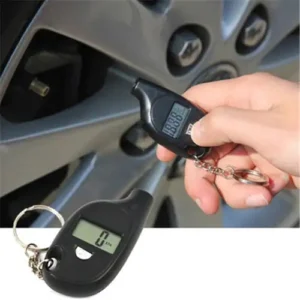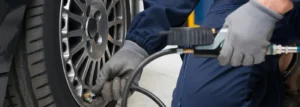Blog
How to Choose the Right TPMS for Your Fleet
How to Choose the Right TPMS for Your Fleet
Managing a fleet of vehicles comes with its own set of challenges, especially when it comes to safety and maintenance. A Tire Pressure Monitoring System (TPMS) is one of the most critical tools for ensuring your fleet operates efficiently, safely, and cost-effectively.
But with so many TPMS options available, how do you select the best one for your fleet? This guide breaks down the key factors to consider when choosing the right TPMS for your business.
Why a TPMS Is Essential for Fleet Management
A well-implemented TPMS does more than monitor tire pressure; it provides valuable insights into vehicle performance and maintenance needs. Here’s why every fleet needs a reliable TPMS:
- Enhanced Safety
- Proper tire pressure reduces the risk of blowouts and accidents.
- Prevents uneven wear that can compromise handling and braking.
- Cost Savings
- Maintains fuel efficiency by minimizing rolling resistance.
- Extends tire lifespan, reducing replacement frequency.
- Compliance with Regulations
- Many countries require commercial vehicles to have functional TPMS installed.
- Operational Efficiency
- Minimizes downtime by identifying issues before they escalate.
- Helps fleet managers plan maintenance proactively.

Types of TPMS for Fleets
Before selecting a TPMS, it’s important to understand the two primary types available:
1. Direct TPMS
- How It Works: Uses sensors installed inside each tire to measure air pressure directly.
- Benefits:
- Highly accurate pressure readings.
- Real-time monitoring.
- Detects slow leaks.
- Best For: Fleets that prioritize precision and real-time alerts.
2. Indirect TPMS
- How It Works: Relies on the vehicle’s ABS system to detect changes in tire rotation speed, which can indicate under-inflation.
- Benefits:
- Less expensive than direct TPMS.
- Easy to integrate into existing systems.
- Best For: Fleets with tight budgets or less frequent monitoring needs.
Key Factors to Consider When Choosing a TPMS
1. Fleet Size and Vehicle Type
Different fleets have different needs. For example:
- Small Fleets: May benefit from simple systems with user-friendly displays.
- Large Fleets: Require scalable solutions capable of monitoring multiple vehicles simultaneously.
Consider vehicle types as well—trucks, trailers, buses, and delivery vans may require specialized sensors or systems.
2. Monitoring Range
For large fleets operating across wide areas, a system with an extended monitoring range is essential. Wireless systems that connect to centralized dashboards or apps are ideal for keeping track of all vehicles in real time.
3. Data Integration and Reporting
Advanced TPMS options integrate with fleet management software, allowing managers to:
- Access historical tire performance data.
- Generate maintenance schedules.
- Analyze trends to improve operational efficiency.
4. Durability and Weather Resistance
Fleet vehicles often operate in harsh conditions. Ensure the TPMS sensors are durable enough to withstand:
- Extreme temperatures.
- Rain, snow, and dust.
- Rough terrains.
5. Ease of Installation and Maintenance
Look for systems that offer:
- DIY installation for smaller fleets.
- Professional setup for larger or more complex fleets.
- Long-lasting batteries or solar-powered options to minimize maintenance.

6. Real-Time Alerts and Notifications
Choose a TPMS that provides instant alerts for issues like:
- Sudden pressure drops.
- Overheating tires.
- Slow leaks.
Real-time notifications can prevent accidents and reduce downtime.
7. Scalability
If your fleet is expected to grow, invest in a scalable TPMS solution that allows easy integration of additional vehicles.
8. Budget Considerations
While direct TPMS systems tend to be more expensive, they provide greater accuracy and reliability. Consider the long-term cost savings from improved safety, fuel efficiency, and reduced tire wear when evaluating your options.
Top TPMS Options for Fleet Management
Here are some of the best TPMS options available for fleet operators:
1. TireMinder Fleet TPMS
- Monitors up to 22 tires per vehicle.
- Smartphone app integration for real-time updates.
- Ideal for trucks and trailers.
2. PressurePro FX Fleet TPMS
- Bluetooth-enabled with easy installation.
- Scalable for fleets of any size.
- Cloud-based data reporting.
3. EEZTire TPMS
- Supports up to 26 sensors per vehicle.
- Rugged design for harsh conditions.
- Real-time alerts for pressure and temperature changes.
4. Doran 360 Fleet TPMS
- Advanced reporting features.
- Durable sensors designed for commercial vehicles.
- Integrates with existing fleet management systems.
5. Continental ContiPressureCheck
- Monitors pressure and temperature continuously.
- Compatible with multiple vehicle types.
- Designed for seamless integration into fleet operations.
Implementation Tips for Fleet Managers
1. Train Your Drivers
Ensure your drivers understand the importance of TPMS and how to respond to alerts. Regular training can prevent misinterpretation of data and unnecessary delays.
2. Conduct Regular Maintenance
Schedule routine checks for TPMS sensors to ensure they’re functioning correctly. Replace batteries or sensors as needed to avoid gaps in monitoring.
3. Use Data for Predictive Maintenance
Leverage the data collected by your TPMS to predict tire issues before they occur. This proactive approach minimizes downtime and extends tire life.
The RegalXMuse Advantage
At RegalXMuse, we understand the unique challenges of fleet management. That’s why we offer a curated selection of TPMS systems tailored for fleets of all sizes.
Why Choose Us?
- Wide Range of Options: From entry-level systems to advanced, scalable solutions.
- Expert Support: Our team is here to help you select and implement the right TPMS for your fleet.
- Competitive Pricing: High-quality products at affordable rates.
Conclusion
Choosing the right TPMS for your fleet is an investment in safety, efficiency, and cost savings. By considering factors like fleet size, vehicle type, and integration capabilities, you can find a system that meets your specific needs.
At RegalXMuse, we’re committed to helping you make informed decisions for your fleet. Browse our collection today and take the first step toward smarter, safer fleet management!


